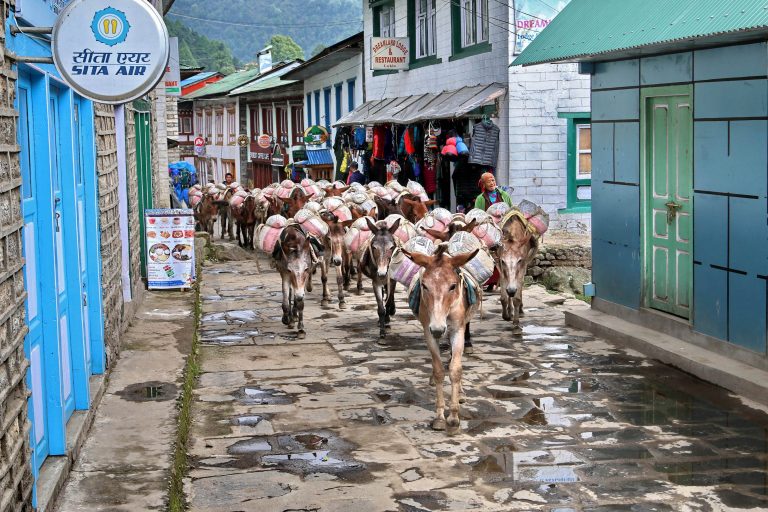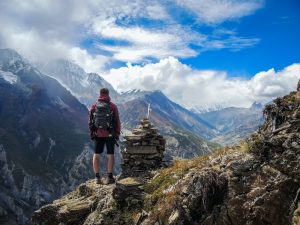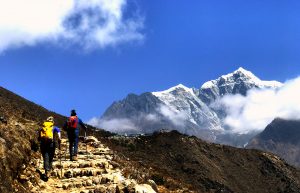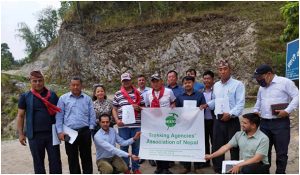
The chance to hike to or climb Mount Everest, the highest mountain in the world is a dream that millions of people share. Ever since the early 1900s, when the first attempts to climb it began, human beings have developed a romantic fascination with Everest and its eternal snow-capped summit.
To date, just over 6,300 people have managed to climb to the summit, while every year 50,000+ people make the trek to the base camp. This number is rapidly growing every year as more and more of us flock to make this dream a reality.
One such person is me, Aran Davies, who first walked to Everest Base Camp back in 2010.
I walked two weeks for eight hours a day through some of the most beautiful scenery on the planet. One day, after spending half a day walking in clouds not seeing a thing, the sky seemed to suddenly open up, and there, standing like a great pyramid over a deep valley was Mount Everest. I was mesmerised. I was already standing at around 13,000 feet, and this mountain seemed to rise and rise and rise above me. It was a very humbling experience.
I was so enchanted that I vowed to return again and again to relive the experience. I made good on my promise and did a further two hikes before the Covid pandemic brought the world to a halt.
With the lifting of global travel restrictions, it was not long before I excitedly headed back to Nepal once again. However, this time, I would come face to face with the darker side of trekking in the Himalayas.
Walking with the donkeys in Everest

Since my last trip in 2017, Everest tourism has boomed. According to statistics released by the Nepali government, the number of visitors to the country’s numerous national parks increased from 70,218 in 2010 to 197,786 in 2019, an 181 per cent increase in just nine years.
This seemingly endless stream of tourists all require food, hot showers, comfortable beds, accessible plug sockets for charging their phones, medical supplies, and, of course, a reliable supply of chocolate bars to sustain them at these high altitudes. Oh, and yes, there is now WiFi available up there as well.
Without roads, the locals rely on a growing army of donkeys and yaks to haul everything from gas cylinders to beds up often dangerous and landslide-prone trails to get them to where they are needed.
There are no official figures on the number of these animals but locals claim that there are now anywhere up to 1,000 donkeys being used as pack animals to haul goods up the trails.
Lower down, rugged roads enable SUVs to deliver supplies to local communities. However, when the roads end or become too perilous, donkeys are employed to transport goods.
It was around the end of the first week’s hiking that I reached this point.
I had seen a small number of donkeys on my first three trips but never anything like this. It seemed like there was now a never-ending line of donkeys making their way with their heavy loads up and down the trails. I reasoned that it must have gotten a lot busier up past the main trekking entry point at Lukla, where the world’s highest airport allows most hikers easier access to the main Everest trek.
Continuing up the trail, I was about to confront the consequences of the swift increase in the number of donkeys and the Nepali drover who guided them along the trails.
I had just started hiking when I came up behind a line of about 20-30 donkeys that were being driven through a small village. Many were fully loaded carrying two gas cylinders that weighed about 15kg each.
My stomach turned when I witnessed the young Nepali drover take his stick and double-handedly begin thrashing one of the poor donkeys that had the misfortune to be stuck at the very back. He was doing it to try to get the column to walk faster. The problem is that the donkeys ahead were all going at the same speed. The poor creature had nowhere to go, most of the tracks here are single-file.
Holding back his mix of disgust and anger, I decided to confront the drover after witnessing him trash several more donkeys with equal brutality. The guy just ignored me and continued thrashing whichever poor donkey got stuck at the back. I could see their ears were fully back and that they were all scared of getting another beating. At that point, I took out my camera to film the sheer brutality of what I was seeing.
I couldn’t help thinking that the absolute degrading cruelty that I was seeing reminded me of U.S POW accounts of The Bataan Death March, where prisoners were continually beaten as they marched. This image was reinforced when I passed a dead donkey that was being stripped of its load and saddle before simply being abandoned on the side of the road. This is exactly what happened to those poor Allied POWs after they had been beaten so badly that they couldn’t continue.
I followed the group for around 10 minutes, all the while filming. He witnessed the drover repeatedly thrash donkeys on their sides and legs, throw stones at their backs, and torment one donkey by repeatedly pushing his stick into its backside.
I could see he was getting some sadistic pleasure out of torturing his victims. Someone like that should never be allowed to work with animals. I never saw this before, it must have to do with the donkey owners just hiring anyone just to make up the numbers.
Finally, so disgusted at what I was witnessing, I decided to pass the train of donkeys to get away.
I remember being struck by how they were so silent as they were beaten and, as I passed them, their eyes seemed void of any hope, as if knowing that they had but one choice, to continue to take the beatings as they go. No one is coming to save them, they will be worked and beaten until they cannot go on anymore, then they will be stripped of their load and left for dead on the side of the road.
Too cruel to continue
At this juncture, I decided to forgo the hike, as I could not bear to be a part of this distressing cruelty any longer.
On my way down I passed numerous other donkey trains, a few of which had good drovers who did not beat their donkeys but rather only yelled at and pushed them. However, most of the new drovers who have been brought in to deal with the ballooning tourist numbers seem to think beating them until back and blue is acceptable.
I was once again angered after witnessing another drover beat a donkey.
I confronted him and asked how would he like it if I thrashed him in the face with a stick as he just did to that donkey. He just stared at me with that look you sometimes see in child soldiers – expressionless and void of any compassion.
Back in Kathmandu, I reflected on my trip and the choice I made to refrain from hiking in Nepal until the government takes action to address this barbaric treatment of animals.
I met a German couple on the way back who had been equally disgusted by what they had seen. They used the word “slavery”, and I think that what I had seen would fit some of the behaviour of the worst slavemasters in the Transatlantic slave trade.
They told me it had kind of ruined their trip and that they had tried to cut down on the food that they were eating while they were up there so as not to be a participant in what I am now calling the “Everest Death March”
I want to emphasise that donkey abuse is happening because we are visiting Everest in increasingly larger numbers. We are the root cause of this brutality, and it falls upon us to take action to put an end to it. Unfortunately, the local police and government appear indifferent. We hold a moral obligation to ensure that measures are taken. I can only hope that someone with the authority to make a difference is reading this.
























